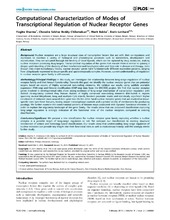| dc.contributor.author | Sharma, Yogita | en_US |
| dc.contributor.author | Chilamakuri, Chandra Sekhar Reddy | en_US |
| dc.contributor.author | Bakke, Marit | en_US |
| dc.contributor.author | Lenhard, Boris | en_US |
| dc.date.accessioned | 2015-03-06T09:27:08Z | |
| dc.date.available | 2015-03-06T09:27:08Z | |
| dc.date.issued | 2014-02-13 | eng |
| dc.identifier.issn | 1932-6203 | |
| dc.identifier.uri | https://hdl.handle.net/1956/9468 | |
| dc.description.abstract | Background: Nuclear receptors are a large structural class of transcription factors that act with their co-regulators and repressors to maintain a variety of biological and physiological processes such as metabolism, development and reproduction. They are activated through the binding of small ligands, which can be replaced by drug molecules, making nuclear receptors promising drug targets. Transcriptional regulation of the genes that encode them is central to gaining a deeper understanding of the diversity of their biochemical and biophysical roles and their role in disease and therapy. Even though they share evolutionary history, nuclear receptor genes have fundamentally different expression patterns, ranging from ubiquitously expressed to tissue-specific and spatiotemporally complex. However, current understanding of regulation in nuclear receptor gene family is still nascent. Methodology/Principal Findings: In this study, we investigate the relationship between long-range regulation of nuclear receptor family and their known functionality. Towards this goal, we identify the nuclear receptor genes that are potential targets based on counts of highly conserved non-coding elements. We validate our results using publicly available expression (RNA-seq) and histone modification (ChIP-seq) data from the ENCODE project. We find that nuclear receptor genes involved in developmental roles show strong evidence of long-range mechanism of transcription regulation with distinct cis-regulatory content they feature clusters of highly conserved non-coding elements distributed in regions spanning several Megabases, long and multiple CpG islands, bivalent promoter marks and statistically significant higher enrichment of enhancer mark around their gene loci. On the other hand nuclear receptor genes that are involved in tissuespecific roles lack these features, having simple transcriptional controls and a greater variety of mechanisms for producing paralogs. We further examine the combinatorial patterns of histone maps associated with dynamic functional elements in order to explore the regulatory landscape of the gene family. The results show that our proposed classification capturing long-range regulation is strongly indicative of the functional roles of the nuclear receptors compared to existing classifications. Conclusions/Significanc: We present a new classification for nuclear receptor gene family capturing whether a nuclear receptor is a possible target of long-range regulation or not. We compare our classification to existing structural (mechanism of action) and homology-based classifications. Our results show that understanding long-range regulation of nuclear receptors can provide key insight into their functional roles as well as evolutionary history; and this strongly merits further study. | en_US |
| dc.language.iso | eng | eng |
| dc.publisher | PLoS | eng |
| dc.relation.ispartof | <a href="http://hdl.handle.net/1956/11904" target="blank">Nuclear Receptor Genes - Regulation and Evolution</a> | |
| dc.rights | Attribution CC BY 4.0 | eng |
| dc.rights.uri | http://creativecommons.org/licenses/by/4.0 | eng |
| dc.title | Computational characterization of modes of transcriptional regulation of nuclear receptor genes | en_US |
| dc.type | Peer reviewed | |
| dc.type | Journal article | |
| dc.date.updated | 2015-03-06T07:22:36Z | |
| dc.description.version | publishedVersion | en_US |
| dc.rights.holder | Copyright 2014 Sharma et al. | |
| dc.source.articlenumber | e88880 | |
| dc.identifier.doi | https://doi.org/10.1371/journal.pone.0088880 | |
| dc.identifier.cristin | 1151699 | |
| dc.source.journal | PLoS ONE | |
| dc.source.40 | 9 | |
| dc.source.14 | 2 | |

